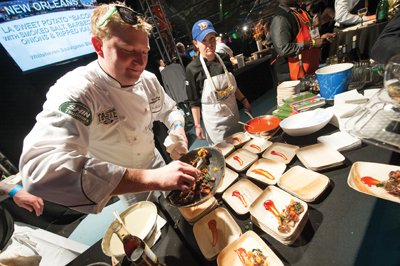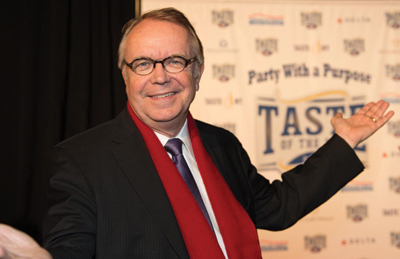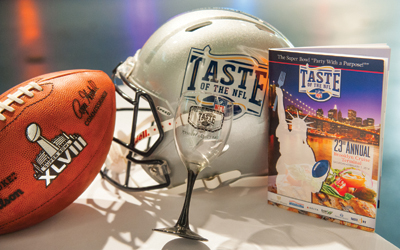Amid the abundance of corporate parties at every Super Bowl, the annual Taste of the NFL benefit is like a safe harbor in a hurricane. Set against the backdrop of commercial excess, and Super Bowl-eve fetes from Playboy, Maxim and others not necessarily renowned for philanthropy, the “Party With A Purpose” long ago became one of the “must” Super Bowl events.
Through its 23 years, Taste of the NFL has distributed more than $15 million to food banks and other organizations battling hunger in America. That figure grows to $22 million when you include money raised through local team versions of Taste of the NFL and Kick Hunger events.
 |
This year’s effort in Brooklyn raised more than $700,000.
Photo by: Taste of the NFL |
Minneapolis restaurateur Wayne Kostroski is downright evangelical about the cause. Even before he started Taste of the NFL in 1992, he was a leader in hunger-relief efforts, beginning when he was looking for a charity tie-in to help make a proposed jazz festival more palatable to neighborhood residents.
By chance, in the summer of 1986, he wandered into a food bank near his restaurant. While he was asking the Joyce Uptown Food Shelf to be the festival’s beneficiary, he saw a single mom with two small children receiving two bags of food.
“That was my ‘aha’ moment,” said Kostroski. So he launched into a series of hunger-relief efforts, some of which combined renowned chefs like Wolfgang Puck with arts and entertainment figures. Since then, Kostroski has been on the boards of other hunger-relief efforts, including Share Our Strength, the End Hunger Network, and the Minnesota Taste of the Nation.
By the time Minneapolis won the 1992 Super Bowl bid, Kostroski was chairing the host group’s restaurant committee. It took only a bit of inspiration to formulate the concept — a strolling wine and food tasting event on the night before the Super Bowl, where chefs from every NFL city would cook and NFL players would reminisce — one food station with a player or two per team.
Adding the NFL imprimatur gave credibility and allowed Taste of the NFL to become the biggest charity event of Super Bowl week. Still, there was the early problem of persuading the chefs, and NFL players, to show up.
“Our original pitch was, ‘Come to Minnesota in the dead of winter, cook your brains out, serve 1,000 people and
 |
Wayne Kostroski started the event in 1992.
Photo by: Taste of the NFL |
you won’t get paid,’” Kostroski recalled.
Somehow they still had the right ingredients. First-year tickets were $75 and the event attracted 900 people, eventually distributing $90,000 to food banks. For this year’s event in Brooklyn, individual tickets were $700, and 3,000 people attended, raising more than $700,000. A total of 3,000 wine glasses were distributed and filled repeatedly, to pair with the 45,000 sample-size servings prepared by chefs.
“From its inception, this was viewed as something with authenticity and real community benefits,’’ said Frank Supovitz, senior vice president of events at the NFL, who serves on the event’s board. “As a result, it’s the most successful not-for-profit event at every Super Bowl.”
Musical acts were added to the benefit in 1997. Barenaked Ladies, REO Speedwagon and the Doobie Brothers have been among the performers.
As the NFL has mushroomed in popularity and chefs have gained national visibility, they have coalesced to form a powerful attraction.
“Athletes want to be musicians, musicians want to be athletes and chefs want to do both,” said Kostroski, adding that he’s so busy on the big night he’s never been able to sample more than three dishes.
Certainly the cause is laudable. Food is the most basic of human needs. However, the adroit exploitation of the fundamental link between spectator sports and food has also fueled the event’s popularity.
“What are our fans doing on any given Sunday during the season?” said Minnesota Vikings CMO Steve Lacroix, a Taste of the NFL board member for 10 years. “They’re tailgating in the parking lot or ‘homegating’ close to their TVs. And now there are so many chefs that are like rock stars, so you have players and chefs who are nationally known personalities.”
Corporate sponsorships for the event run in the six figures. Kostroski said that sponsorship revenue covers 80-90 percent of his annual overhead for the Super Bowl event, which costs more than $1 million to produce and requires hundreds of workers, including volunteers from local culinary schools, along with the athletes and chefs. Neither jocks nor cooks are paid, but the event flies them in and provides lodging. Longtime sponsors include the E&J Gallo Winery, approaching its 20th year.
“Many Super Bowl programs are glorified PR stunts,” said Scott Becher, managing director of Zimmerman Advertising’s Z Sports & Entertainment, which purchased and ran a Taste of the NFL sponsorship for retailer Party City at Super Bowl XLVI. “Taste of the NFL is different, having been established as a part of the fabric of Super Bowl. It offers three things that drive ROI amidst the Super Bowl clutter: a flexible marketing platform, compelling philanthropic support, and a superb turnkey hospitality environment, loaded with celebrity participation.”
 |
| Photo by: Taste of the NFL |
Any annual gala can get stale. However, Jack McDavid of Jack’s Firehouse in Philadelphia, one of two chefs to have cooked every year, said that won’t happen to Taste of the NFL because, in the restaurant business, offering the latest is de rigueur.
“The reason it’s grown is that there are so many entrepreneurs involved,” McDavid said. “Having a variety of new kinds of food, and entertaining people, those are things we’re all thinking about every day in our own restaurants.”
While charitable distribution returns will vary, based on location and overhead, Taste of the NFL shows no signs of slowing. Combining the eight to 10 local Taste of the NFL events staged annually by NFL teams, Kostroski is trying to model the effort more like the NFL, with a regular season of local fundraisers, culminating with a Super Bowl event.
Meanwhile, the country’s hunger problem is growing. “When we started, 22 million were going to be ‘food insecure’ every night,” Kostroski said. “Now it’s 50 million. So we are going in the wrong direction, but it also shows why we can’t stop.”






